Retail Sales Training
Every brick-and mortar retailer wants more shoppers ...
But you don't just want to get bodies in the store if you don't know how to convert them into customers.
In order to build your retail sales, you’ll need to create and fine-tune a retail sales training plan, assess your employee associates, choose the best systems to help you, and inspect what you expect.
Here's how to get started… and a whole lot more.
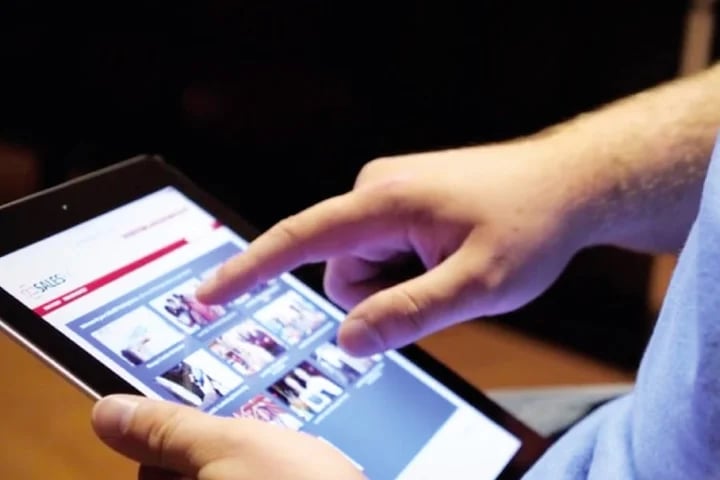
Retail sales training is the process used to train your store associates how to engage a stranger, build rapport and trust, show a product and demonstrate its features and (more importantly) its benefits, contrast and compare products, overcome objections to selling value over price, and close each and every sale.
There are many sales training programs for all types of products, from cars to insurance, luxury aircraft to timeshares, and real estate to software.
But retail sales training is different.
Where the above products have sales cycles that take days, weeks, or even months or years, retail shopping in a store takes only about 20 minutes. It is a short transaction usually involving only one visit and a decision maker.
Where someone looking for new software might have submitted a form or signed up for a trial, and the salesperson then knows a lot about them—enough to also research their prospect on LinkedIn and other social media—a typical retail salesperson is blind; they don’t know who their shopper is, what their needs, wants, or desires are, and what their level of interest is in buying any of it.
That’s why retail sales training is so important. Your associates need to find and relay as much of that information as possible, and in as nice a way as possible, to keep each shopper engaged enough to buy from that salesperson in your brick-and-mortar store that day. And without a discount.
This is the typical approach retailers take to customers; they just want to attract more shoppers and hope to get great reviews on social media.
All retail sales training is trying to do is increase your ability to convert more browsers into customers in your brick and mortar retail store.
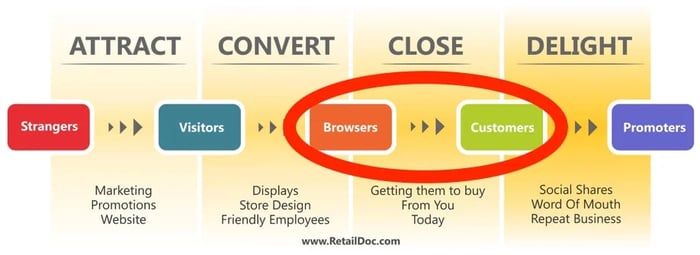
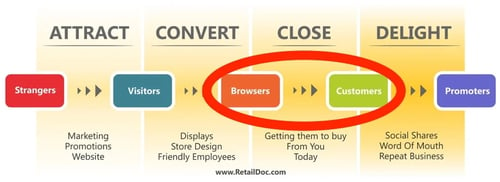
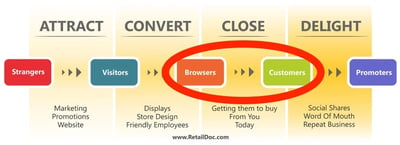

And that's great because people who are willing to leave their house and go to a store or mall are 60% intending to buy something that day.
Retail sales training contains three different elements:
1. Onboarding or new hire training is first. It is your baseline training about how to open and close a register, ring up a sale, ship, stock shelves, pick web orders, use mobile POS on tablets, etc.
2. The second is product knowledge training. Product knowledge training has to go beyond just what’s in the box or how it works. This specialized training should include knowing who this product is for and who it is not, what situations it is good for, competing products in the marketplace, and how to facilitate a hands-on trial. That education helps every employee understand the benefits of a product's features so that they can share them with a shopper.
3. Behavioral retail sales training, the soft skills of how to engage a stranger. After all, all of the product knowledge in the world coupled with the most cutting-edge payment technology is useless if your sales associates don’t know how to greet a customer with an open heart.
Subscribe To RetailRX
The Retail Newsletter over 50,000 Retail Pros read
Insights and tips Retail Industry News Out Weekly
By entering your email you expressly consent to receive other resources to help you improve your marketing efforts.
Without a great retail sales training program, many brick-and-mortar retailers settle for crumbs when they could have the whole feast.




That’s because, left untrained, employees will do little more than point to where something is located, read off the box what the features are to the shopper, and stand behind the counter waiting like a warehouse worker for the next request. With a proper retail sales training program that includes training on the behavioral skills necessary to greet a stranger and build rapport to a level that gains the stranger’s trust, all of your product knowledge can be presented with laser precision that differs from shopper to shopper. That results in higher conversion rates, more units per transaction (UPT), and fewer markdowns.
The thing working against most brick-and-mortar retailers is they are selling someone else’s product, hoping to make a cut. Think of them more like an agent for a celebrity. For several years, the celebrity has been unavailable, and the only way to make a deal was to go through their agent.
That’s all changed. The very brands independent retailers and big box stores carry are trying to go direct to consumers via pop-up shops, apps, and their own websites.
That means it will take more and more to get a shopper to even come into your store, much less buy it from you at the price you need to stay in business.
Instead of offering more discounts to make the sale, the smart retailers take the money they would have gifted shoppers and put it into retail sales training for their crew. That training pays back every moment of every day and with every customer.
Retail sales training is the only sustainable marketing program for brick-and-mortar retailers because untrained employees drive down your overall sales—it takes them longer to sell something than a trained employee. Those associates are inefficient and passive when it comes to driving a sale. That leads to lower conversion rates and lower overall sales.
If you’re serious about competing with online retailers—and you should be—‚you better care about this. Big time.
The good news is that when you have crafted a retail sales training strategy around an excellent customer service experience, every interaction is mapped, every encounter outlined, and metrics can be placed to analyze how well you are doing at creating an exceptional experience. That goes much further than “how much did we do today” or “how did we compare to last year.”




As other brick-and-mortar retailers fail, a great retail sales training strategy gives you a roadmap to the future of who you want to be. While they’re losing customers due to their poor customer experience, you’ll gain new customers (and their customers) as you upgrade your own.
A great retail sales training strategy should include the following:
A customer journey map includes the path from your website to your front door, from the first engagement of the shopper by an associate to the close of the sale, from the delivery of the product to the follow-up and re-engagement.
Specific onboarding materials and training that answer a new employee’s top questions. A good idea is to poll them before their start date so you are ready to address those concerns.
Product knowledge training on your top 25 most popular products. What are you known for? What are the opportunities to add on? These are all important, as are the ability to compare and contrast, know what competitors offer, and overcome common objections.
Behavioral retail sales training has to cover the step-by-step engagement plan you have adopted. I train the
Five Parts to a Sale:
- Greet a shopper like they’re coming to your home.
- Find something in common using a Window of Contact.
- Use one question that gets them to tell you their wants, not just their needs.
- Features and benefits. We don’t buy a knife for what it has, for example, but for what it lets us do with less work. And there’s always an opportunity to upsell or add on an additional product.
- The close. You have to ask for the sale.
Having fewer associates on your sales floor never works if you are serious about competing with online retailers.
You need to staff for the traffic, not the schedule, and ensure those employees have every bit of training possible to confidently help your shoppers buy from you. Miss that, and they’ll repel customers—even those who were once loyal.
Customers aren’t fickle; they want to be treated as someone of value in a store where they are paying their hard-earned money for a product or service.
The Pros & Cons Of Different Kinds Of Retail Sales Training
As I said at the outset, retail sales training encompasses the process used to train your store associates in how to engage a stranger, how to build rapport and trust, how to show a product and demonstrate both its features and its benefits, how to contrast and compare products, how to overcome objections to sell value over price, and how to close each and every sale.
There are, basically, four different types of retail sales training:
1. In-person retail sales training which can work two ways:
- A dedicated on-staff trainer who goes around to stores
- An outside trainer who appears at a company gathering of stores or regions
2. Online retail sales training
3. Shadow or “buddy system” retail sales training
4. Self-paced retail sales training
In-person retail sales training has its own opportunities and pitfalls.




On the plus side, you have Face-to-face training, which is ultimately where you want your associates to excel—face-to-face conversations. When someone from the outside, with a background in training and a curiosity about how individuals learn, delivers the training, the associate does not question it because it has third-party credibility; they believe it better.
Training can be more effective because it can immediately be corrected, explained, and rewarded.
A great trainer is easily understood, engaging, and quickly passes the time.
The downside of in-person retail sales training includes:
Moving many people off the floor or to another location without closing the store can be difficult. Company trainers may show up to train several employees, but due to unexpected schedule changes, those employees have to cover the sales floor. The training can be a firehose of information that is hard to remember. Employees used to standing all day find sitting for long periods uncomfortable. Unless you have a great trainer, the time can go by slowly with little to show.
Online retail sales training has its own pros and cons.




On the plus side:
Online retail sales training can be delivered anywhere in the world and at any time, allowing for a flexible training program.
Anyone who has to sell, no matter what their current level of experience, can learn from a wide range of online retail sales training programs powered by intuitive interfaces specially designed for ease of use.
Anyone should be able to start training immediately without a lot of explanation.
You can ask questions and receive answers in real time. With my online retail sales training program closed captioning technology, you can train anyone, at any location, in most any language.
Specialized modules will specifically meet the needs of sales managers so they know how to coach the online sales training and make it stick.
The best online training programs have comprehensive tracking and reporting tools, allowing management to see how their employees are faring at an at-a-glance basis. They can also view who has been certified by completing the training and who has not.
Costs for retail sales training vary depending on which of the four different types you choose, but here is a good range:
Having an in-house dedicated trainer position runs $35K-$60K annually, depending on their work experience.
An outside trainer who appears at a company gathering could run anywhere from $6K-20K, depending on the expected hours and location.
Online training that you subscribe to starts under $200 per month.
Online training you create in-house can run $50k—$200k. Note that this doesn’t include all the associated costs of additional stakeholder meetings and signoffs required. And there’s no guarantee afterward that your program will truly lift sales until it is out in the field. Shadow training and most self-paced courses are free because they usually depend on using existing employees on the schedule or free videos on the web.
If you use a professional retail sales training program and have a 100% commitment to success from the top down, and if the training is mentored in such a way to inspect what is expected, you should expect a lift in your key performance indicators (KPIs.)
After about 3-6 months, enough of your selling culture should have been upgraded to see a bump in your average number of items per sale and average check. Your retail associates most affect those two.
Retail sales training should include anyone in charge of monitoring or managing your sales staff. That would include your HR Director, OPS Director, District Managers, Managers, and Assistant Managers because if they don’t know what is being trained, how will they know whether the associates are using what is taught?
Here is a video on how to roll out a retail sales training program:
To make sure your training works, the CEO or COO will almost certainly have to be included early in the process so they can allocate additional funding for the project. This is key because you don’t want them to be surprised by the cost or to have unrealistic expectations about what measurable improvements will happen within a month.
You should welcome anyone’s requests for updates and measurements because you have taken the time and have planned from the beginning to get everyone on the same page.
At the store level, you need to align all of your managers by describing why you want to offer retail sales training, what you expect to achieve from it, and how easy it will be to implement.
You don’t want your hard-earned research and planning to be greeted with a roll of the eyes and a look that says look, another thing from corporate to have to do. You need your managers, who are usually on a bonus program for achieving sales targets, to see what a great tool this can be to help them make more money.
Since many stores expect the manager or assistants to train new hires personally for hours, explain how using an online retail sales training program like my SalesRX means scheduling the training, monitoring it, and coaching it. They no longer have to train individually, which allows them to do more—especially during the crush hiring times of back-to-school and the holidays.
Once you have everyone on board, remember that data is your friend. While online retail sales training has testing and certifications built in, using an outside corporate trainer still allows you to build your own tests for comprehension.
However, the biggest way to tell is by listening to the interactions between your associates and shoppers. Several months after starting my SalesRX program, one woman called me and told me that she’d noticed her customers had all gotten nicer since using the program.
I corrected her by saying, “Your customers didn’t get nicer. You did.” When associates learn to build rapport, that learning spills over into your entire corporate culture, which makes your entire retail operation run more efficiently and successfully




If you already are training your employees on how to sell, here are three ways to improve your training:
Role-playing. Many employees say they hate it, but any trainer worth their pay loves it. That’s because the value of role-playing isn’t the employee in front of the group trying to see what they learned, but rather the whole group seeing themselves and learning not to make the same mistakes.
Huddle. Hold a daily morning huddle to keep your associates focused on your customers, not tasks. Give them one aspect of selling they can all focus on that day. At some point, it’s not so much we need to be taught as much as we need to be reminded.
Unpack. When something goes wrong and results in a customer complaint or a lost sale, privately get with the salesperson and unpack how the sale went down. You are looking for where friction developed or trust didn’t. Make it a learning exercise and ask the associate what they could have done differently. Don’t do their thinking for them; make them make the connections in their brains. It does them no good to just listen to you talk.
If you’ve been training, your numbers have not lifted, or your employees are not taking your online courses, you must step back. You need to look at yourself hard to discover why the training is not working.
If the training is from a third party and you know it works, ask yourself if it was launched effectively. If they aren’t taking to the training, maybe they feel they are above having to train at all. They also could be challenging you, letting you know that they don’t think much of you or your training.
That said, if they were bad employees before you started retail sales training, they’ll still be bad employees once you begin. It is not unusual to have to replace employees who do not have the will to change.
Retail sales training can teach anyone how to build rapport and make a sale, but it does not give them the will to do it.
And threatening that you will fire them if they don’t take the training won’t work—because, without an open heart, they’ll just want to get through it. They won’t end up using it.
If your training is all in-house, look hard at your materials and methods. Would a stranger know exactly what they were supposed to do without explanation? If not, you have some work to do.
Once you’ve overcome all the hurdles to starting a retail sales training program, how do you keep up the momentum?
The key is to share your key metrics of average ticket, average number of units per sale, and conversion rates with everyone. Ideally, these would all be public, so your employees can see that those who have taken the training enjoy higher sales.
Those who aren’t using it or struggling will need some counsel to understand this is not just the initiative of the day and that you’re serious about expecting results.
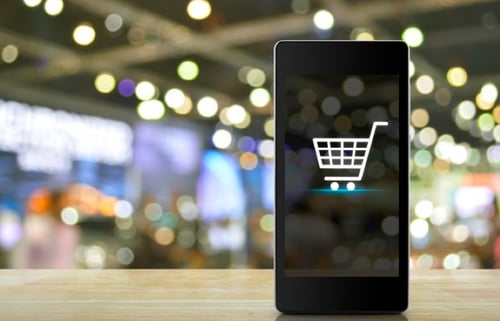

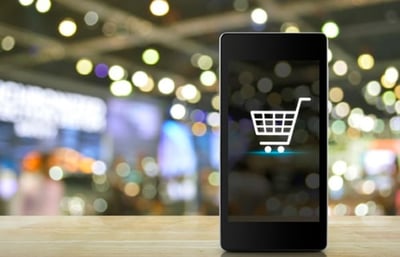

Quite simply, there is nothing I need to drive to your brick-and-mortar store to purchase that I can’t buy online.
Since most retailers make their money selling widely available brands, you can only compete on price and experience.
The days of leveraging price and promotion are dead. There’s always someone cheaper online. A store's only differentiator is to craft a truly exceptional experience. While it might happen independently with a particular associate or a really engaged shopper, conversions are still hit-or-miss.
Retail sales training, like a movie or a good book, has a structure that is understandable and repeatable. You can build your sales any time and with anyone, as long as your shopper receives an exceptional experience.
Particularly for Millennial employees who grew up on video games and instant rewards, online learning is uniquely able to deliver bite-sized moments that build up to a complete selling presentation. Their generation is the most educated and hopeful group you can hire. Video training speaks to them and teaches them the soft skills they didn’t accumulate through their life experiences in a quick and easy way.
Some retailers still look at their employees as disposable and now are thinking they can just open an online store and be successful. If it were 20 years ago, I would agree.
 15 Impressive Strategies To Get The Most Out Of Your Retail Sales Training
15 Impressive Strategies To Get The Most Out Of Your Retail Sales Training
To be truly effective, retail training must provide practical, actionable information for employees to use. This guide will outline tricks and strategies to ensure your employees have the tools they need to confidently engage with your customers.
A big challenge can arise from employees not knowing why you are doing this or what will be expected. Your goal is for them to master the learning, not just get through it, so explain that there will be plenty of time to practice and ask questions.
As I’ve said earlier, if someone was a bad associate before you offered new or expanded sales training, they’ll still be a bad employee. And if you let them, they’ll poison your whole crew with the idea of training before you even start.




If you know from past experience you have someone like that, you need to take them aside and have a heart-to-heart; just ask them what they think of the idea. A good place to do this is at a coffeehouse, away from all other employees.
After they give you reasons why it won’t or can’t work, ask if they can think of any other reasons. Then, ask them to suggest how those problems might be dealt with.
Tell them you’re going to offer sales training and that you will take their suggestions to heart. Make it clear that you are going forward and need them to support it 100%. Don’t leave until they can agree, and then tell them you won’t be having this conversation again and that you appreciate their 100% support.
When it comes to retail sales training, do the following:
- Choose an in-person trainer or online training with a proven track record.
- Give plenty of heads-up to your team so they feel comfortable.
- Be patient. Changing behavior takes time.
- Allow time for employees to be off the sales floor and away from distractions.
- Make continuous improvement a brief, daily topic of conversation with your crew.
This one article, if put into practice by retailers across the globe, could be the foundation for how to compete against online retailers and win.
Whatever method you use, however you deliver it, and whatever it costs, your goal is to raise conversions of shoppers visiting your brick-and-mortar store and to limit discounting. Retail sales training is just a tool to help you accomplish your goal of achieving higher sales.




You’re training to create an experience people want to have instead of just educating associates on product knowledge.
Shoppers are armed with more data than ever when they walk through your doors, so you have to use your own data to measure just how well your associates are converting your browsers into buyers.
Shifting your focus from just getting retail associates to understand a sales process and moving them to using it will help you create better customer service and increase your shopper satisfaction scores and reviews, all of which will result in an exceptional experience for each and every shopper.
- 1. Introduction: What Is Retail Sales Training?
- 2. The 3 Elements Of Retail Sales Training
- 3. Why Is Retail Sales Training Necessary?
- 4. What Should Retail Sales Training Involve?
- 5. Cost Of Retail Sales Training
- 6. Retail Sales Training For Management & Staff
- 7. Measuring & Improving Your Retail Sales Training
- 8. Retail Sales Training And The Era Of Online Shopping
- 9. Addressing Challenges In Retail Sales Training
- 10. Conclusion: Retail Sales Training Creates Exceptional Experiences
Read More About Retail Sales Training
Related Blog Posts:
Live Webinar with Bob
If you're not sure if SalesRX is right for you, there's a good chance you're not ready for SalesRX. You need to first learn the five shifts brands use to stop hemorrhaging retail sales to online store owners. This free on-demand training is jam-packed with 100% actionable tactics PROVEN to increase retail sales.
You can keep losing business to Amazon and the other Ship-to-Self crowd… or you can get an unstoppable strategy through my on-demand training in 30 minutes or less.


